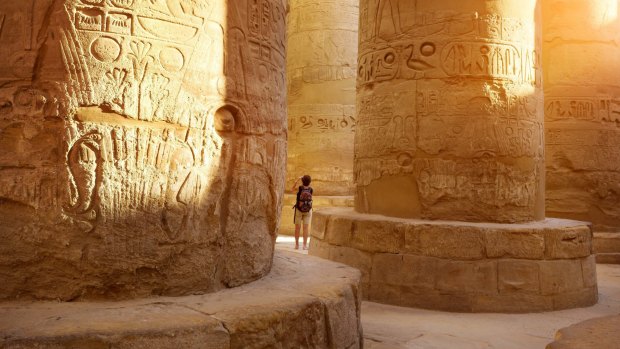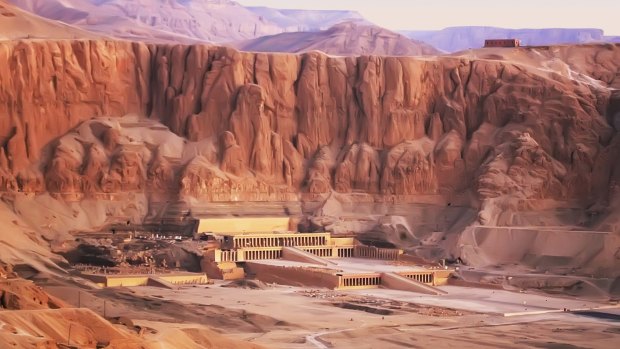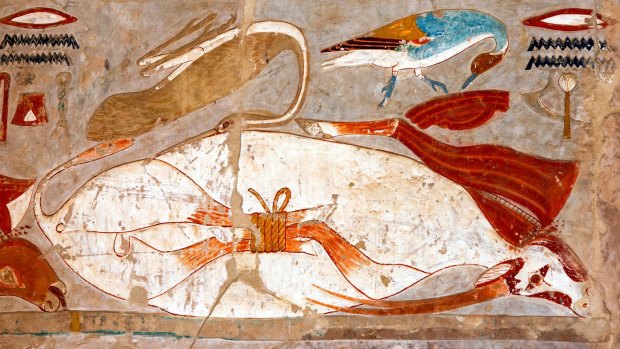This was published 5 years ago
Egypt small group tour: The best way to see Egypt's top ancient attractions
By Ute Junker

Karnak Temple (Hypostyle Hall), Karnak, Egypt.Credit: Shutterstock
Most teenagers were begging their parents to go to Disneyland. Me, I wanted to go to Egypt. For years I had been enchanted by images seen in books: those mysterious pyramids, the elaborate mummification rituals, the animal-headed gods, from Thoth with his ibis head to the crocodile grin of Set.
My parents, bless them, obliged, and that first trip to Egypt still remains one of the most memorable experiences in a lifetime of travelling. Decades on, I still have so many vivid memories of the trip: the incredible scale of the temple of Karnak, the surprisingly small tomb of Tutankhamen, the dazzling jumble of treasures in the Egyptian Museum.
All these years later, I have decided it's time to return. I've put it off for years. For a while, Egypt's tourism boom put me off; following the crowds has never been my thing. Then came the upheaval of the revolution, which made Egypt feel like a no-go zone.

Luxor on The River Nile is a popular place for tourist boats to moor prior.Credit: Shutterstock
Now, however, the time feels right to return. Revisiting these ancient monuments, I expect to be awed and inspired all over again – and I am. What I'm not expecting is to discover anything new. After all, I am going over old ground. Egypt, however, has some surprises in store for me.
Our itinerary takes in all the highlights, from the pyramids at Giza to the temples at Abu Simbel, but my personal journey of discovery starts in the city of Luxor. This is where the ancient Egyptian capital of Thebes once stood; no wonder, then, that the city is home to some of Egypt's most impressive temples, including Luxor Temple and the mighty Karnak, an extraordinary complex that covers two square kilometres. No other building on earth has been so sacred for so long: every pharaoh for 1500 years added to this temple. The first stones were laid as Stonehenge was being completed; the last pharaoh to make additions to the complex was Alexander the Great's brother-in-law.
I have very clear of memories of Karnak's most striking features, including the extraordinary hypostyle hall, sprawling over 5000 square metres and dominated by 134 papyrus-topped columns that soar up to 20 metres in their air. Equally arresting is the Avenue of the Sphinxes which leads into the temple. I remember being awed by the two rows of sphinxes guarding the road; today I am awed when our guide, Hassan – whose also works as an archaeologist – tells us that his colleagues have discovered the rest of the avenue which linked Karnak with the temple of Luxor under a modern road. Excavations are underway; perhaps on my next trip, I'll be able to see the whole three-kilometre avenue.

Mortuary Temple of Hatshepsut, Luxor.Credit: Shutterstock
Luxor's treasures pale in comparison with the treasures on the other shore of the Nile. On the eastern bank, the Egyptians built a city of the living; on the western bank, they erected their cities of the dead. This is where you find the magnificent tombs of the Valleys of the Kings and Queens, among the country's top attractions. While the treasures that once filled the tombs were famously stolen by tomb robbers, the tombs are still worth visiting for the intricate decorations executed in astoundingly vivid colours – glowing yellows, bright blues, gentle greens and rusty reds. These same colours once coated the temples, but have been scoured off by thousands of years of sun and wind.
The West Bank is also where you find the pharaohs magnificent mortuary temples. My teenage self was most intrigued by the mortuary temple of Queen Hatshepsut, the greatest of the female pharaohs. The decorations on the triple-terraced monument celebrate Hatshepsut's famous expedition to Somaliland. The Somali expedition returned to Egypt bearing prized incense trees; incredibly, two survivors of that expedition can still be seen in front of the temple. They are looking twisted and desiccated but, at more than 3000 years old, the fact of their survival is astounding.
Carvings of the incense trees are still on the temple walls just as I remember them. The depictions of Somaliland also show villages filled with distinctive stilted round huts, flanked by coconut palms and accessed by ladders. Hassan draws our attention to the depiction of Somaliland grandees, particularly the Somali leader's wife, a rather corpulent woman with hugely rounded hips, seated on a donkey. Hassan points to the accompanying hieroglyphics. The ancient Egyptians had a sense of humour, he reveals. "This inscription here sympathises with the donkey," he tells us with a straight face.

An engraved relief at the Mortuary Temple of Hatshepsut, Luxor.Credit: Shutterstock
However, the West Bank's treasures don't stop there. On one of our free days, Hassan suggests an optional excursion to visit some noble tombs. It was an honour for a noble to be buried close to the royal burial grounds, and written permission from the pharaoh was required. Several thousand tombs have been identified, but few of them get any visitors. This unplanned excursion, however, turns out to be one of the highlights of our trip.
We visit a number of tombs but the one that takes my breath away belongs to Ramose, a hereditary noble who served both Amenhotep III and Amenhoteop IV. Ramose's roles, according to the inscriptions in his tomb, included vizier, mayor, superintendent of royal works, judge and overseer of priests and temples. He also rejoiced in a series of honorific titles, including "Doer of Truth" and "Hater of Deceit".
While many of the other tombs contain scenes of daily life, the decorations in Ramose's tomb focus on two themes. Some of them portray his relationship with the pharaoh. The most vivid images, however, show Ramose's funeral. We spend ages examining the carefully-depicted funeral banquet, where the heaped food offerings include baskets of grapes and figs, sides of beef, fish and fowl, beer and wine, and even lettuce. The images are vivid, but not as vivid as the depictions of Ramose and his family members.
There are two remarkable things about these detailed portraits. One is their elegance. Each strand of hair, each fold of cloth has been carved into the limestone with unerring grace. This workmanship may be thousands of years old, but it is utterly exquisite.
The second remarkable thing about these images is that, unlike figures we have seen in other tombs, these have not been painted in bright colours. This is unusual, and presumably unplanned: the most likely explanation is that Ramose died earlier than expected, and some shortcuts had to be taken in order to get his tomb ready in time. However, the absence of colour reinforces the elegance of the carvings, magnifying their impact even more.
We only have time to visit a handful of tombs, but one thing is clear: there are more treasures to be uncovered than I ever knew. And that is before we even consider the Grand Egyptian Museum, set to open – after years of delays – this December. Located near the pyramids at Giza, it will for the first time that all the treasures from Tutankhamun's tomb are displayed in the one place. Clearly, it is time to start planning my next visit. One thing is for sure: this time, I won't wait for decades.
Ute Junker travelled as a guest of Bunnik Tours.
5 WAYS TO MAKE THE MOST OF EGYPT
RISE AND SHINE
There are two good reasons to get up early in Egypt: to beat the heat, and to beat the crowds.
ASK THE EXPERT
Archaeologists know more about Egypt's relics than anyone else; choose a tour where you are accompanied by a bona fide expert.
EAT LOCAL
Egyptian cuisine is filled with delicious flavours so make sure you try some favourite dishes, from ful medames (fava beans and lentils) to lentil soup.
KEEP IT SMALL
The monuments may be big, but the real beauty is in the tiny details. Travelling in a small group lets you see more, in more detail.
BUY SMART
Haggling can be intimidating but in Egypt, it is an essential skill. Ask your guide for tips and don't start negotiating unless you really want to buy.
TRIP NOTES
MORE
FLY
Etihad Airways and Emirates both fly from Australia to Egypt. See etihad.com and emirates.com
TOUR
Bunnik Tours' 12-day Highlights of Egypt includes visits to Cairo, Luxor, the Valley of the Kings and Abu Simbel, as well as a three-night Nile cruise. Rates start from $5975 per person twin share, including return airfares from Australia and internal flights in Egypt. See bunniktours.com.au
Sign up for the Traveller Deals newsletter
Get exclusive travel deals delivered straight to your inbox. Sign up now.